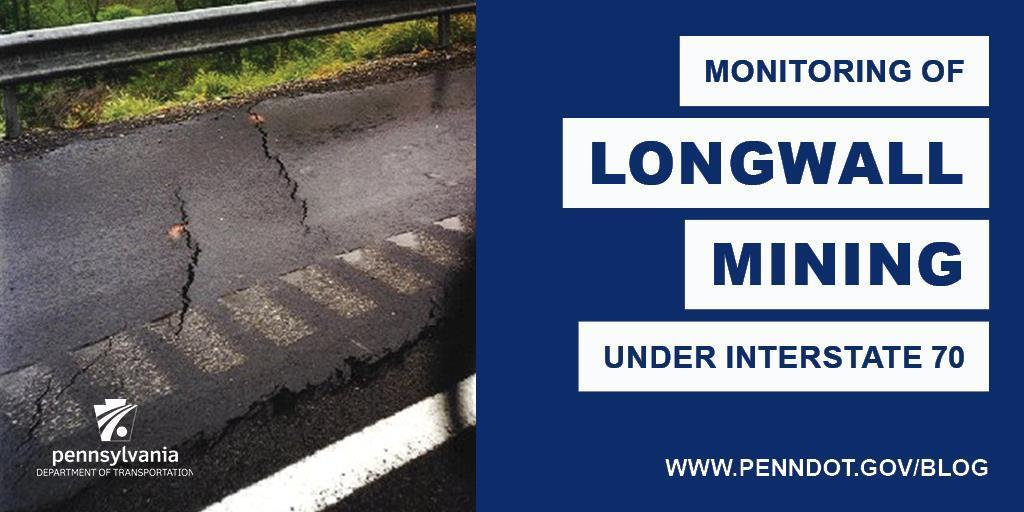
Coal mining has been a way of life in southwestern Pennsylvania since the late-1700s. No longer the pick-and-shovel process that it used to be, mining has evolved with the longwall process, which, driven by modern technology, has made it much more progressive and a challenge to surface integrity.
Longwall mining is a process of removing coal in long strips (channels) underneath the ground. A cutting head moves back and forth across a panel of coal about 1,200 to 1,400 feet in width and more than 10,000 feet in length, 300 to 1,300 feet underground. The cut coal falls onto a conveyor belt and is carted away for removal. The process is done under hydraulic roof supports (shields) that are advanced as the seam is cut. The roof in the mined-out areas falls behind the shield as it advances. When it falls, the surface also sinks.
PennDOT's District 12 first experienced longwall mining under Interstate 79 in Greene County in the summer of 1982. Since then, longwall mines have advanced underneath one of the district's interstates 24 more times over a 27-year period from 1982 to 2009. Longwall mining is expected under Interstate 70 in the district again nine more times over the next 19 years.
In January, Alliance Coal's Tunnel Ridge Mine had a working panel under I-70 between approximately 1,000 feet in West Virginia and the Claysville Interchange in Washington County. As a precaution to motorist safety, single-lane restrictions were established, and the speed limit was reduced to 45 mph in Pennsylvania to slow traffic. Additional Tunnel Ridge Mine panels will pass under I-70 nine times between 2019 and 2038.
When longwall mining occurs, the interstate can be expected to settle about 2-5 feet in some areas. Because of this concern, PennDOT has a multiphase monitoring plan in place to keep track of the interstate longwall mining activities:
-
Alliance Coal Co. will provide daily updates on the mining conditions and the face positions.
-
3-D LiDAR scans will show the contour of the land before the mining occurs for continual comparisons.
-
Tiltmeters, piezometers, and inclinometers were installed to show ground movement at the surface. These devices are used as an alarm system. When the movement exceeds an allowable limit, a message is sent alerting personnel trained to respond.
-
Continuous human inspection is provided at the site to monitor actual damage to the roadway. The inspector is in constant communication with appropriate personnel to coordinate remedial activities.
-
Survey data is collected to monitor and plan for future events.
For minor damage such as cracking and compression bumps, PennDOT's county maintenance forces and contractors will keep the road safe for travel by milling and spot patching. After the mining is out from beneath the section of the interstate, and the ground settling has finished, we will use emergency contracts to repair the surface damage.
To help monitor the ground movement, PennDOT is using top-of-the-line innovative technology. We have enlisted the help of 3-D dynamic LiDAR scans. LiDAR, which stands for light detection and ranging, is a remote sensing method that uses light in the form of a pulsed laser to measure ranges (variable distances) to the Earth. These light pulses—combined with other data recorded by the airborne system— generate precise, three-dimensional information about the shape of the Earth and its surface characteristics.
LiDAR is fundamentally a distance/elevation technology. From an airplane or helicopter, LiDAR systems actively send light energy to the ground. This pulse hits the ground and returns to the sensor. Basically, it measures how long it takes for the emitted light to return back to the sensor. In the end, it gets a variable distance to the Earth. LiDAR data will be collected by airplanes and ground technology. GIS – Inertial Measurement Unit (IMU) tracks the planes' position.
Our main goal is to protect the traveling public and keep the millions of I-70 motorists moving across Pennsylvania.
Joseph J. Szczur is the district executive for PennDOT's District 12, which covers Fayette, Greene, Washington, and Westmoreland counties.
ABOUT THIS BLOG
Did you know PennDOT is directly responsible for nearly 40,000 miles of highway and roughly 25,000 bridges? We oversee programs and policies affecting highways, urban and rural public transportation, airports, railroads, ports and waterways, in addition to administering the state's more than 11 million vehicle registrations and 8.8 million driver's licenses.
So, how do we do what we do? And how can we help you travel in Pennsylvania — whether it be for business or leisure — in safe and enjoyable manner? Read PennDOT Way to learn more about the department, what we do, and how and why we do it.
TAGS
50-Year Anniversary, 511PA, Aggressive Driving, Airports, Autonomous Vehicles, Bicycles, Bridges, Child Safety, Community Relations, Construction, COVID-19, Distracted Driving, District 1, District 10, District 11, District 12, District 2, District 3, District 4, District 5, District 6, District 8, District 9, DOTcom, Driver and Vehicle Services, Emergency Responders, Employment, Equity, FAQ Friday, Human Trafficking, Impaired Driving, Innovations, Live Free Ride Alive, Maintenance Monday, Motorcycles, Older Drivers, PA Motorcycle Safety Program, Pedestrians, PennDOT Connects, Ports, Public Transit, Railroads, REAL ID, Road MaP, Roadside Beautification, Rural Roads, Safety, School Buses, Seat Belts, State Transportation Innovation Council (STIC), Sustainability, Teen Drivers, Throwback Thursday, Transportation Funding, Travel in PA, Welcome Centers, Winter, Work Smart, Work Zone, Yellow Dot
LATEST POSTS
PennDOT Continues Sharing, Updating Resources for Local Governments to Pursue Bipartisan Infrastructure Law Funding Opportunities
Norwin High School Wins 2024 ‘Innovations Challenge’
Demo Complete: I-95 CAP Project in Center City Philadelphia
PennDOT Archeologist Connects Past, Present, and Future
Lehigh Valley DUI, Highway Safety Task Force Hosts Law Enforcement Seminar
ARCHIVES
2024
2023
2022
2021
2020
2019
2018
2017

